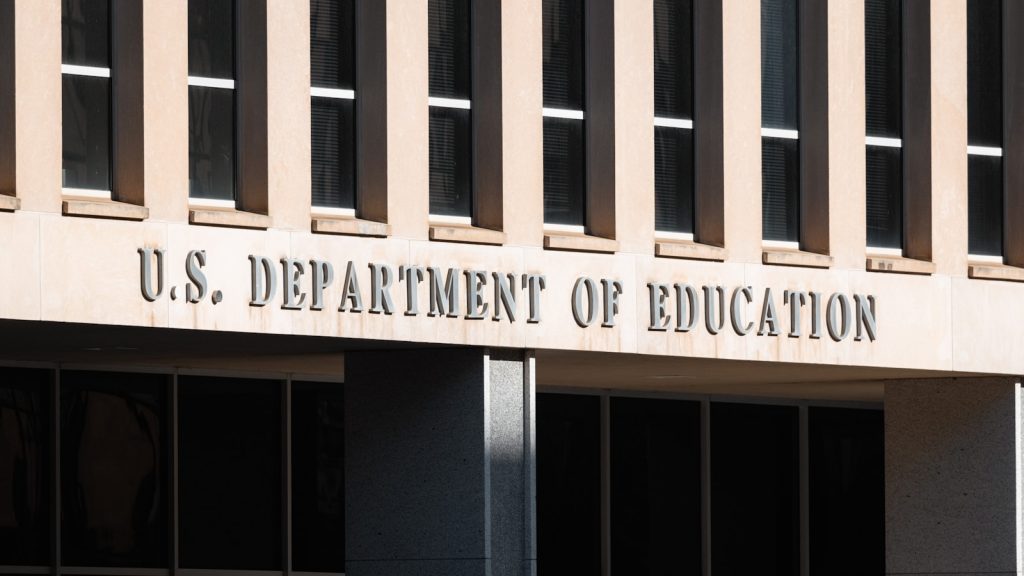
Much has been written concerning the impending fate of the U.S. Department of Education in the aftermath of Donald Trump’s victory and in anticipation of an incoming Congress under G.O.P. control. Can a president eliminate an agency of the federal government? Will President Trump attempt to do so? How could the Department be dismantled? And what might any such attempt mean for the nation’s private schools?
Can President Trump eliminate the Department of Education?
The short answer is: almost certainly not on his own. According to an analysis prepared for the conservative Heritage Foundation by legal researchers Paul Larkin and John-Michael Seibler, U.S. constitutional provisions stop short of affording a president such power, and “…the President currently has no general statutory authority to reorganize the executive branch.” While Article II of the Constitution contains three clauses – the Executive Vesting Clause, the Appointments Clause, and the Opinion Clause – that address the reorganization of the executive branch, none would furnish a president with the authority to shutter an agency of the federal government.
Congress can delegate the authority to create, abolish, divide, or consolidate an agency to a president, but must do so through the enactment of legislation that spells out the limits of such authority in detail, and extends it for a defined period of time. Whereas under such circumstances a president can move to reorganize federal agencies through the issuance of executive orders, any such actions remain subject to congressional nullification. Congress first extended such reorganizing authority with the passage of the Economy Act of 1932 (see Section 403, ff.), and did so most recently in 1984.
If a right-wing think tank such as the Heritage Foundation (which itself promotes the view that the U.S. Department of Education should be stripped of cabinet-level agency status), acknowledges that a president lacks the authority to eliminate a federal agency on his own, it is doubtful that reputable legal sources would opine otherwise.
Will he try anyway?
In a September, 2023 video, then-candidate Donald Trump outlined “10 key ideas that will power our movement for great schools.” To these he added: “One other thing I’ll be doing very early in the administration is closing up the Department of Education in Washington D.C. and sending all education and education work and needs back to the states.” Mr. Trump made similar insinuations during the course of his 2016 presidential campaign but desisted from mounting any serious effort to dismantle the Department after assuming office. In 2018 he floated a proposal to blend the Department of Education and Department of Labor into a new entity to be called the Department of Education and the Workforce. Beyond generating some fleeting buzz the plan, presented as part of a broader reorganization initiative, went nowhere.
Why would Mr. Trump make eliminating the Department a recurring campaign pledge if he had no actual intention of following through?
A possible answer is that the threat of closing the Department offered political advantage, whereas actually doing so would invite political liability. In proposing the closure of the Department, Mr. Trump was able to hit multiple notes that resonated with his base. These consisted of portraying the Department of Education as:
- an exemplar of a bloated federal bureaucracy and wasteful government spending;
- an antagonist in the culture wars by dint of its enforcement of Title IX and other civil rights laws;
- an enabler of ‘woke’ curricula such as critical race theory; and,
- a usurper of state and local control over education decision making.
To what extent can the U.S. Department of Education be said to own responsibility for national outcomes in K-12 education?
Thomas B. Fordham Institute President Michael J. Petrilli suggests “four big ways” in which the federal government “…is making it harder than it should be to run excellent schools” in a recent, intriguing article titled: “How much blame does the federal government deserve for America’s mediocre schools?“
Now that Mr. Trump has won the White House for a second and final term, electoral considerations will quickly give way to the practical politics of governance. During the first year of his new term the votes that will matter most are those cast by members of Congress, and obtaining the authority to dismantle the Department of Education would likely require the expenditure of far more political capital than President Trump will see fit to expend. Attacking the Department may have proven effective while on the campaign trail, but most members of Congress (including most Republicans) are likely to regard any serious effort to eliminate the Department as an unnecessary distraction from more consequential and pressing matters.
For those reasons don’t expect President Trump to aggressively pursue the dismantling of the U.S. Department of Education. If anything, I’d look for Mr. Trump to give the appearance of following through on his campaign utterances by taking some dramatic, if purely symbolic action such as zeroing out funding for departmental operations in the budget proposal he’ll be presenting to Congress shortly after taking office. Alternatively, he could assemble a task force or panel to further investigate the matter or simply hand the ball off to Elon Musk and Vivek Ramaswamy.
But if he did try…
…how might he proceed? Here, it is important to remember that the primary purpose of federal agencies is to implement and enforce laws enacted by Congress. If somehow, some way, the U.S. Department of Education was to disappear, some element of the executive branch of government would still be required to oversee the programs established and funded by Congress. That being so, the most logical approach to eliminating the Department of Education would be to farm out its various functions to other federal agencies.
As shown in the table below, the overwhelming majority of the Department of Education’s total budget of $268 billion is allocated to three offices: Federal Student Aid, Elementary and Secondary Education, and Special Education and Rehabilitative Services. The Department’s Office of Federal Student Aid dwarfs all others. The recently botched rollout of an updated Free Application for Federal Student Aid (FASFA) brought a deluge of unwelcome notoriety to the Department’s Federal Student Aid operations, leading some to suggest that the Department of the Treasury is better positioned and resourced to provide oversight of the massive student aid programs (see box at right). If President Trump is serious about breaking up the Department, seeking Congressional authority to effect such a transfer of responsibility from Education to Treasury seems like both a sensible and defensible place to start. Even so, I’d place the chances of seeing any meaningful movement in this direction as only slightly better than the likelihood of peace breaking out in the Middle East.
In a recent article, former Institute of Education Sciences Director Mark Schneider offers several examples of how functions currently performed by the U.S. Department of Education could be parceled out to other agencies. With regard to the Office of Federal Student Aid, he writes: “At $1.7 trillion, the federal student aid program roughly equals a bank the size of Wells Fargo or Citibank, the third- and fourth-largest in the nation. Wells Fargo has over 226,000 employees to manage its portfolio, while the department has fewer than 4,400 spread across all its functions and fewer than 1,500 in the Office of Federal Student Aid. Managing the equivalent of a large bank clearly lies outside the capacity and skill set of the Education Department.”
| Department of Education Office/Cost Center | FY 2024 Spending |
| Federal Student Aid | $160.69B |
| Elementary and Secondary Education | $82.99B |
| Special Education and Rehabilitative Services | $20.66B |
| Postsecondary Education | $3.51B |
| Vocational and Adult Education | $2.17B |
| Innovation and Improvement | $1.11B |
| English Language Acquisition | $912M |
| Institute of Education Sciences | $786M |
| Department Management | $691M |
| Other | $58M |
| Source: Bureau of the Fiscal Service |
What might any of this mean for private schools?
If, as was imagined above, the U.S. Department of Education was to simply disappear, the programs that offer equitable services and other benefits for private school students and educators would continue to exist. Unless Congress was to terminate appropriations for hugely popular programs enjoying bipartisan support, such as Title I (for students at greatest risk of academic failure), Title II, Part A (providing professional development for teachers and administrators), and IDEA (furnishing services to children with special needs), some agency of government would be required to implement and enforce their underlying provisions of law.
Transferring oversight of these programs from the Department of Education to other federal agency could presage trouble for participating private schools. For example, as a matter of longstanding policy, the Department has made it clear that private schools whose students and/or educators receive federally-funded services offered under either the Elementary and Secondary Education Act or the Individuals with Disabilities Education Act are not regarded as recipients of federal financial assistance. (See item #11 of this departmental FAQ.) The importance of this determination, which has remained intact regardless of which party currently occupies the White House or controls Congress, cannot be overstated. That’s because compliance with Title IX, and other federal civil rights laws that attract the spotlight in the education culture wars, is limited to schools deemed recipients of federal financial assistance.
Department of Education staff attorneys have consistently maintained that the federally-funded services provided through the programs it oversees are intended for the ultimate benefit of students, rather than schools. Importantly, not all federal agencies take the same view. For example, the U.S. Department of Agriculture, which administers the National School Lunch Program, regards private schools opting to participate in that program as recipients of federal financial assistance. There is no guarantee that if oversight authority was to be shifted from the Department of Education to another federal agency, established guidance would remain intact.
A federal agency’s culture, developed over the course of decades (or longer) by career staff (not political appointees) may not be readily transportable. Private schools have long relied upon the U.S. Department of Education to serve as a fair and impartial final arbiter of complaints arising over alleged violations of relevant federal education laws by state departments of education and local public school districts. Private and public school leaders have also been extraordinarily well served by the Department’s Office of Non-Public Education, whose stellar staff can be relied upon to help all interested parties achieve a common understanding of the law in a timely and constructive manner. Any reorganization that relocates such authority to another federal agency risks delays, discontinuity, and the potential weaponizing of rule making and departmental guidance.
In a recently penned article titled, “Will Trump eliminate the federal role in education or weaponize it?” Chester E. Finn, Jr. observes that Donald Trump and Republican leadership have “…long sent exceedingly mixed messages when it comes to K–12 education and the federal role therein.” Adducing evidence in support of his view that contemporary American conservatism is home to both ‘Centralizers’ and ‘Decentralizers’, Dr. Finn wonders aloud whether the incoming administration may actually strengthen the Department of Education’s role.
In closing, and on a personal note, while it is easy (and understandable) for many to regard the U.S. Department of Education as a faceless bureaucracy tasked with applying so much needless and costly red tape, having worked with and coming to know many of the Department’s career employees, I hold a completely different view. It has almost uniformly been the case that departmental staff with whom I have worked have been shining exemplars of excellence in civil service – brilliant, dedicated, creative, ultra hard working, fair-minded, responsive, and oftentimes charismatic. While there’s always room for improvement of the system in which they operate, and the laws they are required to enforce, it would be a grave mistake to believe the nation is not well served by the people at ED.
